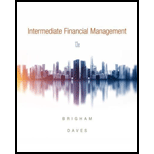
Define each of the following terms:
- a. Operating plan; financial plan
- b. Spontaneous liabilities; profit margin; payout ratio
- c. Additional funds needed (AFN); AFN equation; capital intensity ratio; self-supporting growth rate
- d.
Forecasted financial statement approach using percentage of sales - e. Excess capacity; lumpy assets; economies of scale
- f. Full capacity sales; target fixed assets to sales ratio; required level of fixed assets
a)
To discuss: Operating plan and financial plan.
Explanation of Solution
Operating plan is a short-term, highly detailed plan that is formulated by management of the company to achieve tactical objectives.
Financial plan is plan that identifies revenues and expenses. It defines specific goals like budgeting, cost associated with operations and sales projections.
b)
To discuss: Spontaneous liabilities, profit margin and pay-out ratio.
Explanation of Solution
Spontaneous liabilities are the liabilities which are resulted from purchasing of goods and services on credit basis and incur the obligation to pay for those goods offerings at some time within the future.
Profit margin is the ratio of profit after taxes to cost-of-sales, expressed in terms as a percentage. It is one of the measures of the profitability of a firm, and acts as an indicator to its cost structure.
Pay-out ratio is a taxable payment declared through a company’s board of directors and given to its shareholders out of the company’s current or retained earnings, usually quarterly.
c)
To discuss: Additional funds needed, AFN equation, capital intensity ratio and self-supporting growth rate.
Explanation of Solution
Additional funds needed (AFN) are those funds required from external sources to expand its assets to aid a sales growth. A sales increase will generally require an increase in assets. However, some of this growth is generally offset with a spontaneous growth in liabilities as well as by way of earnings retained in the firm.
AFN equation is as follows,
Capital intensity ratio is the amount required which means capital required per dollar of revenue and sales.
Self-supporting growth is the rate of growth that an entity can achieve with its own, not required to raise any external finance.
d)
To discuss: Forecasted financial statement approach by using percentage of sales.
Explanation of Solution
The forecasted financial statement approach using percent of sales develops a entire set of financial statements that may be used to calculate free cash flows, projected EPS, and various financial ratios. This method first forecast the sales, the required assets and then net income, dividends and retained earnings.
e)
To discuss: Excess capacity, lumpy assets and economies of scale.
Explanation of Solution
A firm has excess capacity when its sales can grow earlier than it ought to add fixed assets consisting of plant and equipment.
Lumpy assets are those assets that can’t be acquired smoothly, but require large, discrete additions.
Economies of scale occur the ratios are likely to change over the years as the size of the company increases. For example, retailers often want to maintain base stocks of various inventory items, even if current sales are pretty low. As sales expand, inventories might also grow less rapidly than sales, so the ratio of stock to sales declines.
f)
To discuss: Full capacity sales, target fixed assets to sales ratio and required level of fixed assets.
Explanation of Solution
Full capacity sales are calculated as actual sales divided by using the percentage of capacity at which fixed assets were operated. The target assets to sales ratio is calculated as actual fixed assets divided by way of full capacity sales.
The required level of income is calculated as the target fixed assets to sales ratio multiplied through the projected income (sales) level.
Want to see more full solutions like this?
Chapter 9 Solutions
Intermediate Financial Management (MindTap Course List)
- solve this question.Pat and Chris have identical interest-bearing bank accounts that pay them $15 interest per year. Pat leaves the $15 in the account each year, while Chris takes the $15 home to a jar and never spends any of it. After five years, who has more money?arrow_forwardWhat is corporate finance? explain all thingsarrow_forwardSolve this finance problem.arrow_forward
 Intermediate Financial Management (MindTap Course...FinanceISBN:9781337395083Author:Eugene F. Brigham, Phillip R. DavesPublisher:Cengage Learning
Intermediate Financial Management (MindTap Course...FinanceISBN:9781337395083Author:Eugene F. Brigham, Phillip R. DavesPublisher:Cengage Learning Intermediate Accounting: Reporting And AnalysisAccountingISBN:9781337788281Author:James M. Wahlen, Jefferson P. Jones, Donald PagachPublisher:Cengage Learning
Intermediate Accounting: Reporting And AnalysisAccountingISBN:9781337788281Author:James M. Wahlen, Jefferson P. Jones, Donald PagachPublisher:Cengage Learning- Principles of Accounting Volume 2AccountingISBN:9781947172609Author:OpenStaxPublisher:OpenStax College





